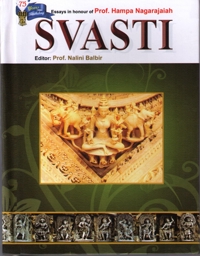26
Humanism and Jainism
The origin of humanism
Humanism as a philosophical and literary movement originated in Italy in the second half of the 14th century and diffused all over Europe. As an atheistic theory it was conceived in 17th century by French philosophers but as a theistic, pragmatic theory it was conceived indirectly around 2000 B.C. at the time of Vedas, Sramana Tradition and Upanishads in India. The Prayer - sarve atra sukhinaḥ santu sarve santu niramāyāḥ “Let all be happy here and let all enjoy full health” of Vedic Sages echoed the Universal welfare.
The philosophy of Humanism has had many incarnations during the long history of mankind. In India, the humanistic tradition also started with Jain Acharyas who gave the tenet, śivam astu sarvajagataḥ “Let there be welfare of the whole world”.
The western tenet, given by Protagoras is “Man is the measure of all things” (The truth above all things is man; there is nothing above him). “Humanism is any philosophy, which recognizes the value or dignity of man and takes human nature, its limits, or its interests as its theme.”
Various interpretations of humanism
Humanism is not an established school of philosophy, but is a definite philosophical outlook. It emphasized the worth and dignity of man by rejecting other worldliness and transcendentalism. It is this worldly, man-centered secular philosophical outlook. It claims that the man is self-sufficient and is able to comprehend the world phenomena and work out a certain social order without the help of God. It is an attitude towards and an approach to man’s worldly life and values. It is characterized by interest in man, concern for man, and faith in man’s reason and conscience for discriminating perception of truth and goodness. It also has to take note of man’s cultural history, where values and standards have been discovered and set up by men, for men.
Mahāvīra’s humanism
Mahāvīra’s great contribution to Humanism consists in conceiving a religion that centers almost wholly around man and his life here in this world. Religion, according to him, should pervade all our activities; it cannot and ought not to be pursued in seclusion from one’s fellow-beings and in separation from life’s other activities. The equivalent for Religion is Dharma in Sanskrit, which means moral obligation and connotes individual’s integrity as well as social solidarity. The universe as envisaged in Jain teaching and the motto is parasparopagraho jīvānām[1] “There should be mutual support between living creatures”.
Religious tolerance
Jaina thinkers have consistently shown deference to other ideologies and faiths. In the Sūtrakṛtānga (2nd Century B.C), it is stated that those who praise their own faith and view and disparage those of their opponents, possess malice against them and hence will remain confined to the cycle of birth and death.
sayaṃ sayaṃ pasaṃsantā garahantā paraṃ vayaṃ
je u tattha viussanti saṃsāraṃ te viussiyā.[2]In another famous Jaina work of the same period the Isibhāsiyāiṃ, the teaching of the 45 renowned saints of Sramanical and Brahmanical schools of thinking such as Narada, Bharadvaja, Gautama Buddha and many others have been presented with regard:
Devanāradeṇa arahatā isiṇā buiyaṃ.[3]
Haribhadra’s crusade against sectarianism is unique and admirable in history of world religions. Jainism has a sound philosophical foundation for religious tolerance and throughout the ages, it practically had remained tolerant and regardful to other faiths and ideologies.
Ācārya Amitagati writes a beautiful verse for tolerance –
sattveṣu maitriṃ guṇiṣu pramodam
kliṣṭeṣu jīveṣu kṛpāparatvam
madhyasthabhavaṃ viparītavṛttau
sadā mamātmā vidadhātu deva.[4]Jainism attaches great importance to universal tolerance, an active ingredient of the principle of Ahiṃsā.
Free will in Jain thought
The problem of free will is discussed by almost all renaissance humanists, ‘Man the measure’ is the earliest declaration of humanistic outlook. Humanists confirm that man is the maker of his own destiny.
Free will did not mean slavery to desires of our mind but freedom of ‘rational self’. Once you condition yourself with ‘rational self’, you are free to move within those restraints. In the words of Emerson, “A man is free to speak the truth not to lie, free to serve, not to exploit, free to sacrifice himself but not free to kill or injure”[5].
Morality for Mahāvīra was not a matter of outward conformity but of inward fulfillment, of deep conviction, accomplished by right action. Hence Jainism teaches Triratna “Three Jewels” (Right knowledge, Right faith and Right conduct). The soul has all power to implement the quality of life.
Right conduct
Karma Theory is supreme in Jainism. It is the activity of human beings. There is no concept of grace and God in Jainism. Right knowledge is the knowledge of reality without doubt or error. To acquire this knowledge one should study the teaching of the Tīrthaṃkaras who have attained liberation and are therefore fit to lead others. Right faith is an essential preliminary for right knowledge. It consists in an insight into the truths. Right knowledge in itself is not enough, if it is not followed by right conduct. Right faith, right knowledge and right conduct cannot exist exclusively of each other. Though right conduct is the direct means of liberation: cāritram ante gṛhyate mokṣaprāpteḥ sākṣāt kāraṇam iti jñāpanārtham.[6] Right conduct consists in controlling the passions, the senses, the thoughts, the speech and the action so as to cultivate an attitude of “neutrality without desire or aversion towards the objectives of the external world.”
The right conduct is based on the fivefold moral code which Jainas call panca mahāvrata which are tenets of Ahiṃsā. This fivefold moral code names killing as the biggest sin. Killing includes harming or hurting not only humans or animals but also insects and plants, because Jains believe that plants are in possession of souls. The Jain Munis even breathe through a piece of cloth tied over their mouth, lest they inhale and destroy the life of an organism floating in the air. It is this morbid fear of injuring life that governs the life of orthodox Jains. Thus Jainism prescribes asceticism for the sake of asceticism.
The other rules of the moral code are actually contributory regulations to the main rule of Ahiṃsā. The second code stresses truthfulness (satya) in one’s dealings with others. Asteya or abstinence from stealing is the third rule. The fourth is brahmacarya or celibacy and the fifth is aparigraha or renunciation of worldly objects. All these vratas are to be observed by individuals but they have social connotation.
Human concern, so non violence
For the Jainas, a true religion consists in the practice of equanimity:
samiyāe dhamme āriehiṃ paveie.[7]
And its foundation is the observance of non-violence:
se bemi: je aīyā, je ya paḍuppannā, je ya āgamissā arahantā bhagavanto te savve evam āikkhanti … savve pāṇā, save bhūyā, save jīvā, save sattā ṇa haṃtavvā... esa dhamme suddhe, ṇiie sāsae…[8]
In the Ācārāngasūtra we come across these two definitions of religion. Equanimity is the essence of religion, while the observance of non-violence is its eternal exposition or a social aspect of religion. The Ācārānga mentions that practice of non-violence is the true and eternal religion.
It was agriculture which allowed man to settle down and think about himself as well as think about others. When he started thinking about himself, he expected non-injury, non-violence from others and if he expects non-injury, non-violence from others he also has to behave with others in the same manner.
Jainas speak of violence as unnatural and of non-violence as natural because if you throw somebody into the river, you expect a cause for it but if you save a man from drowning into river, we do not require an explanation for it. It means that love or non-violence is inherent in the nature of things. Non-violence is as natural as fragrance to a flower. Flower emitting fragrance is not conditional. It is, therefore, not conditional. It is unconditional and unmindful of its surroundings. Non-violence is the intrinsic nature of man. It is unconditional and unmindful of its surroundings. It is, therefore, not dependent even on the existence of the other, not to speak of the action of the others. The flower emits fragrance equally not only for its friends and foe but also when it is all alone and there is none to receive its fragrance.
In the literature of world religions, non-violence as a way of life has a very ancient history. Jainism is the ‘Ahiṃsā’ religion par excellence among others. Jainism placed strong emphasis on the ethical principle of Ahiṃsā and also discussed it in epistemology and metaphysics. Ahiṃsā is the central core of Jain philosophy and religion. Ṛṣabha is said to have been the first to preach Ahiṃsā before achieving his own Kaivalya. The preaching of Ahiṃsā is the most important task of Mahāvīra’s life. Feeling of immense respect and responsibility for life inspires his activities. The Jaina doctrine of non-injury is based on rational consciousness, not emotional compassion, on individual responsibility. Though the emphasis is on personal liberation, the Jain ethic makes that goal attainable only through consideration for others. According to Umāsvāti, the author of Tattvārthasūtra, “Nonviolence is unlimited, tolerance unconditional and reverence for life supreme. There is no question of `just war’”.[9]
Padmanabh Jaini has observed that there is a “preoccupation with Ahiṃsā” within Jainism for no other religious tradition “has carried it to the extreme of the Jainas. For them it is not simply the first among virtues but the virtue”.[10] The Doctrine of Ahiṃsā is narrated and analyzed in the Āgamas as follows:
The three matters mentioned above became fruitful in the thought and conduct of Mahāvīra and are woven in the Āgamas. Mahāvīra proclaimed: “There are no quality of soul more subtle than non-violence and no virtue of spirit greater than reverence for life”.
All religions are at one in upholding the primacy of nonviolence. However, Jainism tends to give it a more comprehensive interpretation than anyone of them. The basic principle of nonviolence follows from Jaina metaphysical view that all souls are equal. No one likes pain. One should not do unto others, what one does not want other to do unto one. Hence hurting whether by thoughts, words or deed is looked upon as the basic evil to be overcome.
Non-violence and environment
Jainism is not an abstract philosophy, but a complete life-style, a way of life. It offers physical, moral and spiritual rules of healthy living. The latest technology and best of Science can be incorporated in the Jaina model while reviving the old tradition. It establishes harmony between religious and scientific, spiritual and physical aspects, between personal independence and ecological interdependence. It is the path of purification the basis of which is the principle of non-violence which is the principle pertaining to environment.
According to Jainism, true religion is that which sustains all species of life and helps to maintain harmonious relationship among them. In the Ācārāngasūtra it is said “Ahiṃsā is pure and eternal Dharma”.[11] Non-violence is not restricted to human beings but it embraces the whole Universe. Non-violence is observed by Jaina seers as a rule of nature. It is the first principle of higher life. “All miseries arise from violence.”[12] and also “non-violence is the crux of wisdom”.[13] Not to kill or destroy is the good deed par excellence.
It is said in the Ācārāngasūtra that non-violence comes first because it is the chief of all the vratas. Just as fence is meant for the protection of a field, so also are the remaining vratas meant for the protection of non-violence.
Equanimity
Equanimity is the essence of religion, while the observance of non-violence is its extensional exposition or a social aspect of religion.
One who is unbiased and impartial can perceive the truth of his opponent’s ideologies and faiths, and thus can possess deference to them. Intense attachment unfailingly generates blind faith in religious leaders, dogmas, doctrine and rituals and consequently religious intolerance and fanaticism. Right knowledge, Right faith, and Right conduct (the triratna) of Jainism maintains that Right faith should be maintained and not blind faith. Jainism maintains that Right faith should be followed by right knowledge.
Anekāntavāda
The doctrine of Anekāntavāda or non-absolutism of the Jainas is that on which the concept of religious tolerance is based. Non-violence is the essence of religion from which the concept of non-absolutism emanates. Absolutism represents “Violence of thought” for it negates the truth-value of one’s opponent’s view and thus hurts the feeling of others. A non-violent search for truth finds non-absolutism.
The necessary corollary of Anekāntavāda is non-violence in speech and thought. One must respect others’ point of view. If we insist on truth we must understand the beauty of compromise. This is the philosophy of relativism.
What is required is to be flexible - intellectual fanaticism is dangerous. Therefore, liberalism in thought is advocated. We have to develop a non-absolutistic standpoint attitude on almost all problems. It helps us to understand the viewpoints of others and to reconcile ourselves with the thoughts of others. It helps also to cultivate the spirit of tolerance and understanding. This will increase goodwill and harmony. One has to practise generosity of spirit and avoid fundamentalism. Thus antagonism can be resolved not by quarrels but by communication and understanding. It is the principle of cooperation and co-existence. The result is the establishment of a liberal attitude in our dealings. Anekāntavāda leads to relativity, which states that since truth is relative to different standpoints, one has to consider different aspects of it. It is an ideal for successfully managing conflicts - personal or interpersonal, national or international. It brings about importance of tolerance. Intolerance arises because of unwillingness to accept difference. But according to this doctrine - “he is right, but I am also right”.
The basis of this theory is not merely that reality can be viewed from many angles but also that all views of reality must be equally honored. All views have equal significance.
The basic tenets of Jainism can be summarized in two words - Ahiṃsā and Anekānta. Non-violence and “Standpointism”. These two tenets are principles of peaceful co-existence, which are based on the concept of respect for life. Standpointism signifies open-mindedness. It has been rightly observed that if we accept non-violence as the regulative principle of conduct and standpointism or manifoldness as the basis of our outlook, barbarism and exploitation, war in any form can come to an end.
Jaina thinkers are of the view that reality is a complex one: ananta-dharmakam eva tattvam. It has many facets, various attributes, and various modes. It can be viewed and understood from different angles and thus various judgments may be made about it. Even two contradictory statements about an object may hold true. Since we are finite beings, we can know or experience only a few facts of reality at one time. We cannot grasp the reality in its completeness. Thus Jainism admits human right to hold a different viewpoint. According to Jaina thinkers the truth-value of opponents must be accepted and respected. Non-absolutism pleads for a broader outlook and an open mindedness, which alone can resolve the conflicts that emerge from differences in ideologies and faiths. Equipped with Anekānta, the Jaina appreciates reality in all its aspects. She or he is equipped to understand other people’s viewpoints. This makes her or him a better listener, more sympathetic and more receptive to others and their viewpoints.
He or she is willing to consider any phenomena in its entirety. She or he is diligent enough to examine all precedents, willing to approach any issue with an open mind and unwilling to jump to an instantaneous conclusion.
Such a rational and ethical approach is bound to lead to less violence, less anger and consequently, less anguish.
A true believer of Syādvāda (Non-absolutism) is that who pays equal regards to all the faiths. To remain impartial to the various faiths is the essence of being religious. A little knowledge that induces a person to be impartial is more worthwhile than the unilateral vast knowledge of scriptures.
While in principle Anekāntavāda may appear as a system recognizing multiple worldviews in reality it severed, according to Paul Dundas, as a way which could establish the superiority of the Jain worldview over other models of reality. Based on the critical examination of medieval Jain texts and their authors, Dundas demonstrates the tensions and divisions that existed.
Non-personalism
For the Jains, the object of veneration and worship is not a person but perfectness. The Jains worship quality or merit, not the person. In the sacred navakāra mantra, Veneration is offered to the spiritual-posts such as Arhat, Siddha and not the individuals like Mahāvīra, Ṛṣabha. Veneration is paid to all the saints of the world: namo loe savvasāhūṇaṃ. Jain prayer is addressed to Tīrthaṃkaras only to inspire one for one’s own better self which may be called the conscience, the true self.
The Door of Liberation open to all
Jainism holds that the followers of other sects can also achieve emancipation or perfection, if they are able to destroy attachment and aversion. They do not believe in the narrow outlook that “only the followers of Jainism can achieve emancipation, others will not”. Haribhadrasūri writes: “One who can attain equanimity of mind will for certain get emancipation whether he may be a Śvetāmbara or a Digambara or a Buddhist or any one else”.[14]
Conclusion
Thus, Jainism as an atheist school can be considered as a humanist school of thought. It accepts Non-violence, Non-absolutism, Non-possession, Non-personalism, Equality and Equanimity from human point of view and not for any transcendental reason.
Sāmāyika Pāṭha 1 (Sāmāyika Pāṭha I by Amitagati. Published in Sāmāyikasūtra, Sanmati Jnanapitha, Agra).
Quoted in the Foreword by Mahadev Desai, Gandhi M.K. My Early Life. Bombay: Oxford University Press. 1938, p. VIII.
Translator’s Introduction to Tattvārthasūtra in Nathmal Tatia (ed.) That which Is, San Francisco and London: Harper Collins 1994, p. XXI.
Padmanabh S. Jaini, The Jaina Path of Purification, Berkeley: University of California Press, 1979, p. 167.
 Dr. Geeta Mehta
Dr. Geeta Mehta

